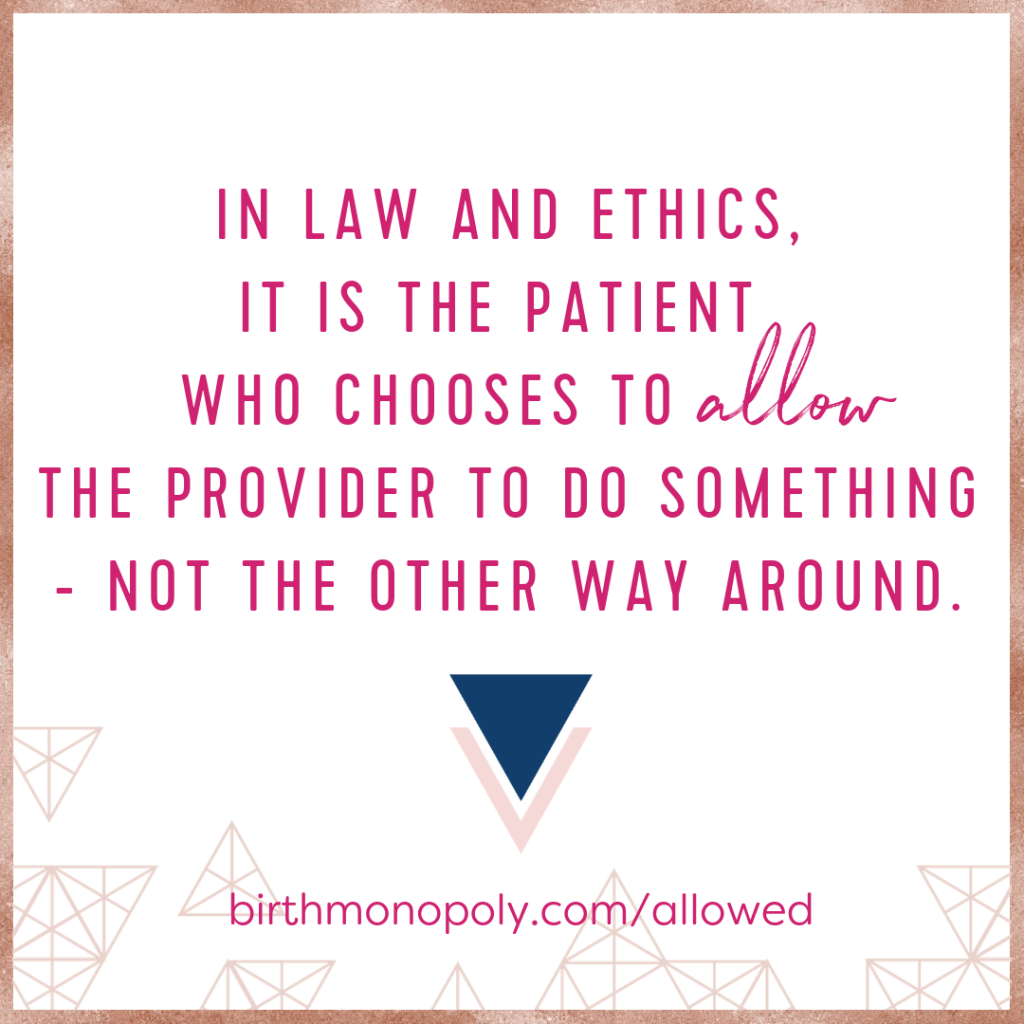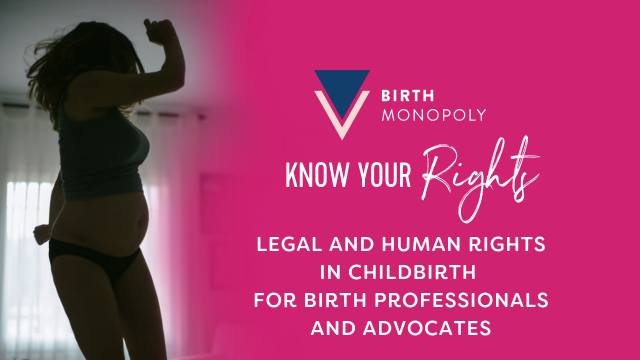For most women, pregnancy and childbirth are one of the few times we let other adults tell us what we are “allowed” and “not allowed” to do with our own bodies. It’s time to change our language around this to reflect the legal and ethical reality that it is the patient who chooses to allow the provider to do something—not the other way around—and to eliminate a word that has no place between true partners in care.
We hear the word “allow” used regularly, by well-meaning care providers and family members, and by pregnant women themselves. During my own pregnancy, I was told I “may or may not be allowed” to hold my baby immediately after he was born, depending on what hospital staff was on shift. It struck me as so odd that I might be in the position of asking to hold my own precious baby, especially when I’d chosen to hire these care providers. Who was allowing whom here?
Most recently, it has been all over the media following the March 2014 release of guidelines for lowering the primary Cesarean rate from the American College of Obstetricians and Gynecologists (ACOG) and the Society for Maternal-Fetal Medicine:
“Women with low-risk pregnancies should be allowed to spend more time in labor, to reduce the risk of having an unnecessary C-section, the nation’s obstetricians say.” (NPR.org)
Or:
“That may mean that we allow a patient to labor longer, to push for a longer amount of time, and to allow patients to take more time through the natural process.” (CBS News Philadelphia)
For women giving birth in the American maternity system, these guidelines are welcome, but they are no magic bullet. Medical practices take years and even decades to change, and while that happens, what assurances do women have about the care they are receiving today? Is it ethical to hold women to what an individual provider will “allow,” with the full knowledge that not all providers are practicing to the standards science show is best for moms and babies?
These are not rhetorical questions. In the U.S., outdated, non-evidence-based practice is routine and accepted; Cesarean section rates vary ten-fold among U.S. hospitals; and those rates vary fifteen-fold among the low-risk population. Over 40% of hospitals defy national health policy by “not allowing” vaginal birth after Cesarean, to the detriment of hundreds of thousands of mothers and babies. The United States is the only developed country in the world with a RISING maternal mortality rate. One factor in that rise is our overuse of surgery for childbirth. We simply cannot operate on the assumption that the surgeries women are receiving are always in their best interests, or that of their babies.
But it’s about more than just a stand-alone decision around whether to do a Cesarean. There’s a sequence of events leading up to that possibility, and many women have been relieved of their decision-making well before that time. When women have been given messages all along that they are not the authority in their own childbirth, it’s easy for a care provider to make a unilateral decision about surgery. What woman, who has experienced nine months of language like “we can’t let you” and “you’re not allowed” is going to suddenly have the wherewithal to refuse an unnecessary surgery—or to even know she has the right to do so?
The truth is that women, like all other U.S. citizens, have the right to make decisions about their bodies based on informed consent—a legal, ethical standard which requires the provider to convey all of the information around a suggested procedure or course of treatment, and the person receiving the procedure or treatments gets to decide whether or not to take that advice. ACOG states clearly about informed consent in maternity care: “The freedom to accept or refuse recommended medical treatment has legal as well as ethical foundations. . . . In the obstetric setting, recognize that a competent pregnant woman is the appropriate decision maker for the fetus that she is carrying” (ACOG Committee on Ethics Committee Opinion No. 390 Ethical Decision Making in Obstetrics and Gynecology; Dec 2007, reaffirmed 2013).

This stands in stark contrast to women being told they are “not allowed” to decline potentially harmful interventions like continuous electronic monitoring in a low-risk pregnancy, or to make an informed decision for a vaginal birth rather than a surgical one–or even to eat, drink, or go to the bathroom in labor.
At its heart, this language is about a lack of respect. It’s how we speak to children, not competent adults. It’s a sloppy way of skipping meaningful and necessary conversations about what should be a common goal for both mother and provider: a healthy, happy birth.
It’s also a reinforcement of deep cultural beliefs about women as passive objects, not full owners of their bodies nor representatives of their babies, and having lesser decision-making capacity than those they’ve hired to support them. These ideas will take time to change. But birth is a great place to start.
Words have power, and we can take back that power in some simple ways:
– Don’t stay silent when you hear this kind of language in casual conversation. Say something—even if it’s just a little something. Don’t let it go unnoticed.
– Be gentle while you are being firm. Remember that most people are just repeating something common and accepted, and they probably haven’t thought much about it. Make it your goal to inform, not convince.
– Choose to give your business to providers who use respectful language. If you’re hearing this language during pregnancy, you can be pretty sure you’re going to hear it during childbirth—and that can be a problem. You can’t act like a mother when you’re being treated like a child.
– Partners, stand up for your loved ones. When she is vulnerable, be her voice. There is no one better positioned to be a vocal advocate for her and her baby.
Today, American women are gambling with their bodies when they give birth, with a one in three average Cesarean rate in facilities where practices vary widely, even among individual providers. And we are tying women’s hands when we continue to reinforce this dysfunction by using words like “allow” to describe an outdated dynamic that doesn’t recognize us as competent, rights-bearing adults.
The legal authority in childbirth lies with the woman giving birth, not the providers of care. Yes, they are a team, but of the two, it is the woman who truly bears the rights and the risks of childbirth. Our words should reflect that reality.

A former communications strategist at a top public affairs firm in Baltimore, Maryland, Cristen Pascucci is the founder of Birth Monopoly, co-creator of the Exposing the Silence Project, and former vice president of the national consumer advocacy organization Improving Birth. In that time, she has run an emergency hotline for women facing threats to their legal rights in childbirth, created a viral consumer campaign to “Break the Silence” on trauma and abuse in childbirth, and helped put the maternity care crisis in national media. Today, she is a leading voice for women giving birth, speaking and consulting around the country on issues related to birth rights and options, and working on a documentary about mistreatment of birthing women.



